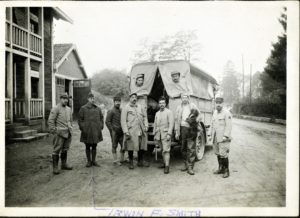Over the last few months, I have been busy with my World War I digitization project for the Northfield-Rice County Digital History Collection. To see all 460+ and counting unique items online, go to http://nrcdighistory.org and click on the “World War I in Northfield” link near the bottom of the page.
The stories that can be found among the digitized materials of the DHC are set in locations both near and far. For example, Northfield-area serviceman Irwin F. Smith, a sergeant in Division Intelligence of the 88th Division, was stationed in the Alsace border region of France. Although we have found no records that specify exactly what Sgt. Smith did as an Intelligence officer, some clues can be found in his scrapbook of photographs that is in the Rice County Historical Society collection. The whole scrapbook has been digitized and you can see some amazing photographs from France during the war – including a set of aerial photographs showing trenchworks and more!

Irwin Smith and French colleagues “somewhere in France”, 1918. See the original on page 7 of his scrapbook on the DHC.
This photograph shows Sgt. Smith standing with unidentified officers and men from the French army. Since America was so late in entering the war, its intelligence-gathering services were not as developed as its allies, and it relied heavily on standards set by the intelligence services of both France and Great Britain. Smith likely trained with and performed his work with these French allies in the field.
While the Allied Forces gained information about the enemy through breaking coded radio transmissions and other methods, they also conducted aerial surveillance using tethered balloons and airplanes equipped with cameras. The aerial photographs showed the locations of enemy trenches, tanks, soldiers, and more. It is very possible that Sgt. Smith was involved in the gathering and analysis of aerial photographs as an intelligence officer, because he had access to dozens of aerial photographs taken in the Alsace region where he was stationed. He kept copies of them in his scrapbook.

Aerial photograph of trenches and shell holes near Bernwiller in the Alsace region, c. 1918. On page 17 of Smith’s scrapbook.
Most of his photographs show locations near Altkirch, a border town in the Alsace region that was affected by the opening attack of World War I by the French Army against Germany in 1914. Smith was not there until 1918, but the evidence of the battles remained in his photographs – miles of convoluted trench works and empty rain-filled shell holes, not to mention the ruins of houses and barns, remain visible in this contested area 4 years after they were destroyed. We can only imagine what they looked like on the ground.
Check out the next post to read about World War I-era Northfield stories closer to home!
View all of the items digitized for this project here.
